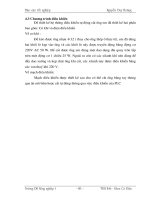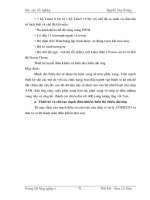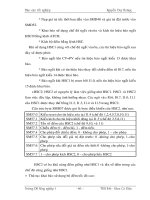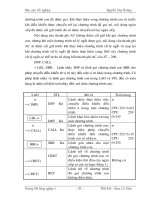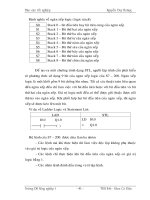Cấu tạo thép tòa nhà - P4
Bạn đang xem bản rút gọn của tài liệu. Xem và tải ngay bản đầy đủ của tài liệu tại đây (468.63 KB, 10 trang )
37
2. THE BEHAVIOR OF THE FRAME
The reinforced concrete consists of two ingredients, the concrete and the reinforce-
ment. The reinforcement is usually made out of steel and rarely (for the time being)
from composite materials.
The reinforcement is divided into two main categories: (a) the
longitudinal rein-
forcement which consists of reinforcement bars and (b) the traverse rein-
forcement which mainly consists of stirrups.
In order to fully explain the behavior of the frame, we will examine two simplified
structures, a simple slab supported in the two opposing sides and a panel consisting
of two columns and a beam which connects the columns.
Abstracts from the book of Apostolos Konstantinideis called EARTHQUAKE RESISTANT BUILDINGS, volume A,
chapter 1.4
Published in low resolution in the site of pi-SYSTEMS International S.A. www.pi.gr
38
1.4.1 Slab reinforcement and behavior
Because of the loads (self weight, marble coverings, loads from humans etc) that it
bears and because of the elasticity that it has, a slab will be deformed as illustrated in
the following picture. Although the real deformation is very small, invisible to the hu-
man eye and can only be measured in mm (millimeters), it always has the form illus-
trated in the picture.
Concrete has very high compression strength and therefore does not need any longi-
tudinal reinforcement in the areas of compression. On the contrary, the tensile
strength of concrete is minimal and therefore it is required to use longitudinal rein-
forcement in the areas of high tension.
The cooperation of concrete and steel reinforcement results in the ideal combination
of materials in order to achieve both high compression strength and adequate tensile
strength.
Abstracts from the book of Apostolos Konstantinideis called EARTHQUAKE RESISTANT BUILDINGS, volume A,
chapter 1.4
Published in low resolution in the site of pi-SYSTEMS International S.A. www.pi.gr
39
In the tensile area of the slab, especially in the middle of this area, the tension cre-
ates small hair cracks invisible to the human eye. However, these cracks do not in-
fluence the static behavior of the slab.
Diagonal stresses are developed at the edges of the slab but these stresses are al-
ways dealt with by the concrete and thus there is no requirement for additional trans-
verse reinforcement.
Because of the development of tensile stresses in the upper fibers of the support ar-
eas of the slab, it is obligatory to use a minimum longitudinal reinforcement. This re-
inforcement can either be autonomous or can originate from the main body of the
slab or even both.
In the particular example of the above picture, the upper or ‘negative’ reinforcement
originates from the main body of the slab (bended reinforcement bars).
Slab reinforced with an industrial steel mesh
In general, slabs do not have to cope with forces imposed vertically to their level of
reference and therefore it is not reinforced to cope with seismic forces.
When it is decided to use a reinforcement mesh for reasons of simplicity and econ-
omy, the only additional reinforcement needed is that of the longitudinal bars in the
support areas of the slab, as illustrated in the above picture.
Abstracts from the book of Apostolos Konstantinideis called EARTHQUAKE RESISTANT BUILDINGS, volume A,
chapter 1.4
Published in low resolution in the site of pi-SYSTEMS International S.A. www.pi.gr
40
1.4.2 Column and beam reinforcement and behavior
PANEL WITHOUT SEISMIC INFLUENCE
The following panel consists of two columns and a beam and is only stressed by the
gravitational loadings and not by any seismic loadings.
The following picture illustrates the deformations and the possible concrete crackings
in a very large scale in order to emphasize the behavior of the elements under the
influence of gravitational loadings. In reality, both the deformations and the crackings
are too small to be visible by the human eye.
Abstracts from the book of Apostolos Konstantinideis called EARTHQUAKE RESISTANT BUILDINGS, volume A,
chapter 1.4
Published in low resolution in the site of pi-SYSTEMS International S.A. www.pi.gr
41
The tension developed in specific areas of the panel will most definitely result in the
development of crackings. Therefore, it is obligatory to use the required reinforce-
ment in every tension area of the panel. When the crackings are perpendicular to the
main axis of the element we must use longitudinal reinforcement (bars) in order to
avoid the further developed of these hair cracks. When the crackings are diagonal we
must use transverse reinforcement (stirrups) in order to constrain these hair cracks.
When the panel is not supposed to receive any seismic loadings it is also possible to
constrain all diagonal hair cracks by the use of special diagonal reinforcement.
PANEL WITH SEISMIC INFLUENCE
The panel illustrated in the following picture is identical to the one describe above.
During its entire life span, it will function in exactly the same way as the previous
panel, except for the crucial moments of the earthquake. The behavior of the panel
during an earthquake is illustrated in the following two pictures.
During the earthquake there are mainly horizontal movements developed. These
movements create horizontal inertia forces (forces created due to the sudden change
in the kinetic condition of an element.
Abstracts from the book of Apostolos Konstantinideis called EARTHQUAKE RESISTANT BUILDINGS, volume A,
chapter 1.4
Published in low resolution in the site of pi-SYSTEMS International S.A. www.pi.gr

